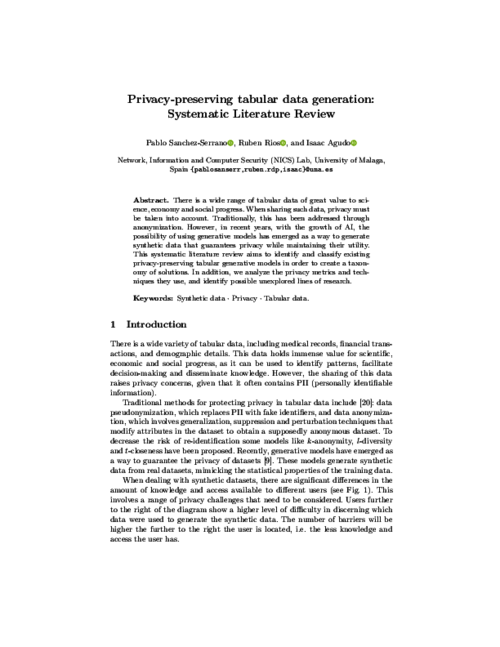Pablo Sánchez
PHD STUDENT
Edificio de Investigación Ada Byron
C/ Arquitecto Francisco Peñalosa, nº 18
Ampliación Campus de Teatinos. Universidad de Málaga
29071 Málaga (Spain)
Phone: +34 951 952 934
E-mail: pablosanserr@uma.es
Current research
- Generative models: evaluation of privacy and utility of AI models.
- Learning from obscured data: encrypted traffic classification.
Ph.D. research
My Ph.D. research focuses on data protection and privacy in artificial intelligence. The objective is to study, design, and develop mechanisms that enable the training of AI models without compromising the privacy of data owners.
Education
- MSc. in Telecommunications Engineering, University of Málaga (September 2025)
- MSc. in Telematics and Telecommunication Networks, University of Málaga (July 2024)
- BSc. in Telematics, University of Málaga (July 2022)
Thesis
- MSc. Thesis: Encrypted Traffic Classification Using AI Techniques.
The increasing use of encrypted Internet traffic raises significant challenges for monitoring, network management, and cybersecurity. This work explores the application of Artificial Intelligence techniques for packet-level encrypted traffic classification. Both Machine Learning and Deep Learning methods have been applied, incorporating feature engineering strategies to improve classifier performance. Experiments were carried out on two widely used datasets in the literature (USTC-TFC2016 and ISCXVPN2016), as well as on a newly created proprietary dataset. The results show that even relatively simple models, such as Multilayer Perceptrons, can achieve competitive performance compared to more complex architectures like CNN-1D, provided that appropriate preprocessing and feature engineering techniques are applied.
The main contributions of this work are: the development of automatic and manual traffic capture tools, the design of an AI-based system for encrypted traffic classification, and the implementation of an interactive application capable of analyzing both real-time traffic and previously captured traces. These contributions not only provide a solid experimental framework but also open the door to practical applications in the fields of network monitoring and cybersecurity.
This work has been carried out within the framework of the CiberIA Project, funded by INCIBE. Furthermore, it lays the groundwork for continuing this research in a doctoral thesis. - MSc. Thesis: IoT device touchscreen user interface integration.
Adding a touchscreen to an IoT device has a number of benefits for both the user and the developer: a more useful, versatile, intuitive and aesthetically pleasing end product, and a flexible way to debug code. However, it also brings with it a number of issues that need to be addressed: economic, memory, space and energy consumption costs, as well as an increase in development complexity. This project creates a library that makes it easy and intuitive for developers to create menus and user interfaces on a microcontroller’s touch screen. In this way, it overcomes the entry barrier of adding the screen to an IoT device. The library is open source and general purpose. The menus were developed following a standard software development flow. It started with the design and then programmed the designed user interfaces. A simulator was used to test the implemented code and once debugged, everything was tested on a real development kit. A search and comparison of libraries and devices was carried out to determine which graphics library was most suitable for the project and which development environment was most suitable for testing. - BSc. Thesis: BLEPass: Hardware Password Manager using Bluetooth Web.
The use of passwords as we know them has several security problems and we have not yet reached the point where more secure forms are widely used. This project aims to reduce the risk of passwords being stolen and, if a password is stolen, to minimise the possible damage by not having to memorise them and to be able to use random passwords. A hardware module has been implemented in which the user’s passwords for different websites are stored. The user can obtain and autofill the password field of the website or save a new password. If the user wants to save a new password, a new one can be generated randomly. This eliminates the need for the user to remember the password. Communication between the two parts of the system has been done via a BLE connection, using Web Bluetooth in the case of the browser extension. A test has also been implemented. It performs several unit tests to check if the functional requirements of the system are met.
Publications
Pablo Sanchez-Serrano, Ruben Rios, Isaac Agudo
A decision framework for privacy-preserving synthetic data generation
In: Computers and Electrical Engineering, vol. 126, pp. 110468, 2025, ISSN: 0045-7906.
@article{Sanchez-Serrano2025,
title = {A decision framework for privacy-preserving synthetic data generation},
author = {Pablo Sanchez-Serrano and Ruben Rios and Isaac Agudo},
url = {/wp-content/papers/Sanchez-Serrano2025.pdf
https://www.sciencedirect.com/science/article/pii/S0045790625004112},
doi = {10.1016/j.compeleceng.2025.110468},
issn = {0045-7906},
year = {2025},
date = {2025-06-13},
urldate = {2025-06-13},
journal = {Computers and Electrical Engineering},
volume = {126},
pages = {110468},
abstract = {Access to realistic data is essential for various purposes, including training machine learning models, conducting simulations, and supporting data-driven decision making across diverse domains. However, the use of real data often raises significant privacy concerns, as it may contain sensitive or personal information. Generative models have emerged as a promising solution to this problem by generating synthetic datasets that closely resemble real data. Nevertheless, these models are typically trained on original datasets, which carries the risk of leaking sensitive information. To mitigate this issue, privacy-preserving generative models have been developed to balance data utility and privacy guarantees. This paper examines existing generative models for synthetic tabular data generation, proposing a taxonomy of solutions based on the privacy guarantees they provide. Additionally, we present a decision framework to aid in selecting the most suitable privacy-preserving generative model for specific scenarios, using privacy and utility metrics as key selection criteria.},
keywords = {},
pubstate = {published},
tppubtype = {article}
}
Pablo Sánchez-Serrano, Ruben Rios, Isaac Agudo
Privacy-preserving tabular data generation: Systematic Literature Review
In: 19th DPM International Workshop on Data Privacy Management (DPM 2024), pp. 170-180, Springer, Bydgoszcz, Poland, 2025, ISBN: 978-3-031-82348-0.
@inproceedings{pablo2024dpm,
title = {Privacy-preserving tabular data generation: Systematic Literature Review},
author = {Pablo S\'{a}nchez-Serrano and Ruben Rios and Isaac Agudo},
url = {/wp-content/papers/pablo2024dpm.pdf},
doi = {10.1007/978-3-031-82349-7_12},
isbn = {978-3-031-82348-0},
year = {2025},
date = {2025-04-06},
urldate = {2024-09-19},
booktitle = {19th DPM International Workshop on Data Privacy Management (DPM 2024)},
volume = {LNCS},
number = {15263},
pages = {170-180},
publisher = {Springer},
address = {Bydgoszcz, Poland},
abstract = {There is a wide range of tabular data, such as medical, financial or demographic data, which are of great value to science, economy and social progress. However, this type of data contains sensitive information. Privacy concerns need to be taken into account when sharing such data. Traditional methods, such as anonymisation or pseudo-anonymisation, are based on modifying databases to meet certain privacy guarantees. In recent years, with the growth of AI, the possibility of using generative models has been raised as a way to generate synthetic data that guarantees the privacy of individuals while maintaining their utility. This systematic literature review aims to identify and classify existing privacy-guaranteed tabular generative models to create a taxonomy that classifies them. In addition, we analyze the privacy metrics and techniques they use, and identify possible unexplored lines of research.},
keywords = {},
pubstate = {published},
tppubtype = {inproceedings}
}




